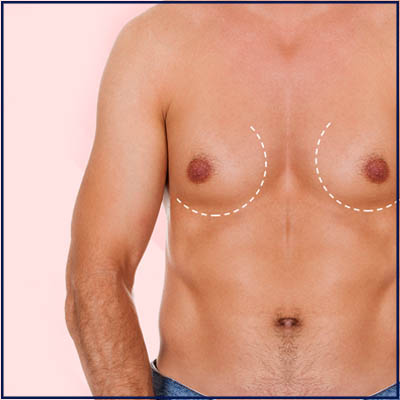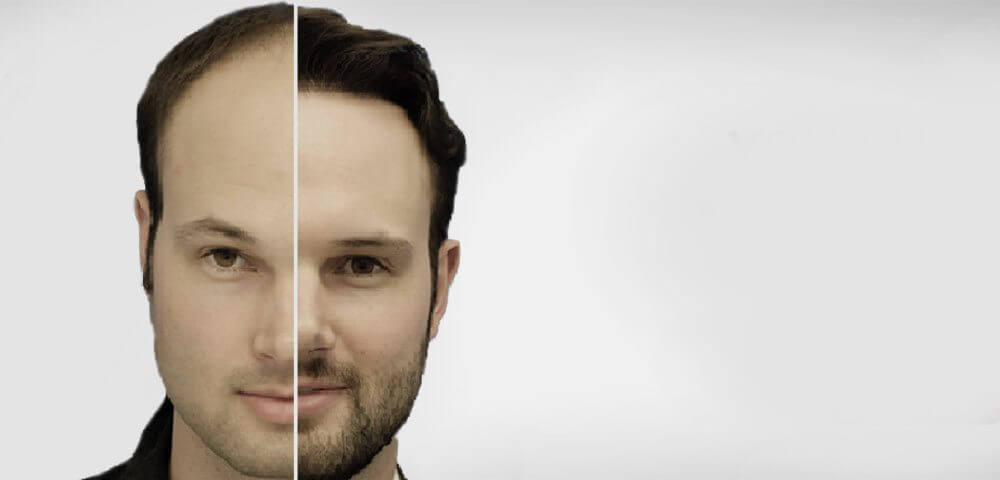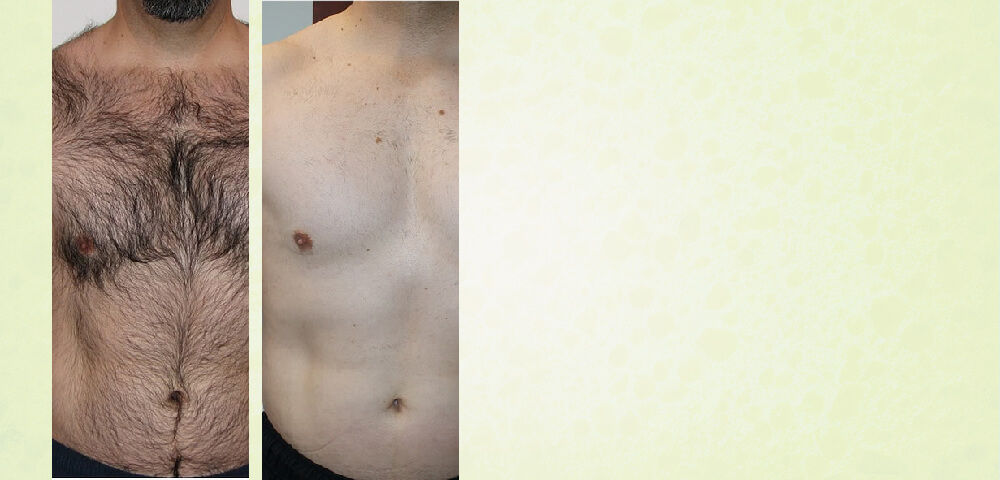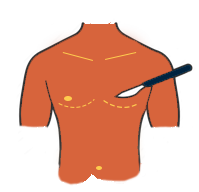Gynaecomastia, Gynecomastia Surgery Or Male Chest Reduction Vizag Visakhapatnam, Andhra Pradesh
- Gynecomastia
- 4 Grades of Gynecomastia
- Physiologic Gynecomastia
- Histology
Introduction to Gynecomastia
Dr. VJs Cosmetic Surgery & Hair Transplantation Centre: Gynecomastia is a condition in which the malfunctioning of the endocrine system leads to an increase in the size of male breast tissue.
Reasons For Gynecomastia
- It usually occurs due to hormonal changes in the body.
- It may also occur due to the side effect of certain medications. It may be due to the presence of some other condition in the body like endocrine disorders or metabolic dysfunctions
What is the age group that gets affected by Gynecomastia?
It may happen at any age and generally is seen during the adolescent years of males. Three-fourths of the cases usually resolve on their own. It may even be seen in newborns due to the influence of maternal hormones.
| Type | Severity | Description |
| Mild | The male breast develops a localized button of tissue around the areola region | |
| Mild to high | It is characterised by moderate enlargement of the breast. | |
| High and visible | It shows as moderate breast enlargement that goes beyond the areola boundaries and .The edges are indistinct from the chest,and one can notice skin redundancy. | |
| Severe | The breast enlargement is highly visible .It is accompanied by skin redundancy and breast feminization. |
4 Grades of Gynecomastia
- Gynecomastia is not seen in equal degrees in different patients.
- There are various characters by which the cases are classified. These are the size of breast enlargement and the degree of feminization.
Causes
A male’s body has both testosterone and estrogen. In normal condition, they are found to be in a balanced state. When the amount of testosterone decreases with respect to estrogen, then the condition can result in Gynecomastia. Testosterone controls the development of sex characteristics of men like muscle mass and body hair. Estrogen hormone is responsible for the development of female characteristics in the body like the development of breasts. If the estrogen level rises and testosterone level decreases in man , it could result in Gynecomastia. Gynecomastia in adolescent boys and middle-aged men occur due to the hormonal imbalance. When newborns show this trait, it is generally due to the presence of maternal hormones in the baby.

- The breast enlargement is highly visible. It is accompanied by skin redundancy and breast feminization.
- Gynecomastia Classification According to Symmetry
- Symmetry is another criteria on the basis of which the Gynecomastia can be classified-
- Unilateral- Gynecomastia appears only in one breast while the other seems to be normal.
- Bilateral- Enlargement of both the breasts indicates the presence of Gynecomastia in both the breasts.
Physiologic Gynecomastia:- Gynecomastia can be seen in both the male and female newborns. It is due to the transfer of the estrogen produced by the placenta to the baby’s blood. Some newborns are also seen to be lactating due to this feature. This condition usually heals by itself after two to three weeks.Adolescents also show this condition in the age group of 10-12 years. This condition usually resolves itself after 1- 1 and a half years.Many times, nutritional insufficiency can also lead to the condition. It soon gets healed when proper nutrition is given to the patient.Many cases might be seen with hereditary diseases like spinal muscular atrophy,bulbar muscular atrophy and aromatase excess syndrome.
Non-physiologic:-Non-physiologic consists of medication given for treating cancer. Flutamide, cimetidine, and ketoconazole are some of the medicines that can cause gynecomastia. Calcium channel blockers have also shown the same tendency.Personal skin care products which contain lavender oil and tea tree oil can also trigger such a condition.
Pathophysiology:-
- The main reason behind gynecomastia is the imbalance between the estrogen and action of androgen at the level of the breast tissue. An elevated increase in conversion of androgens to estrogens may lead to the condition.
- It could also be caused due to a decrease in free levels of testosterone due to conditions like Klinefelter syndrome, orchitis or mumps.
- It could also be caused due to diseases related to the pituitary gland and hypothalamus.
- Decrease in levels of testosterone due to impairment of activity of enzymes responsible for the synthesis of testosterone.
- We may not know it, but the inclusion of eggs and milk in our diet also leads to early puberty and gynecomastia. The reason behind this fact is that the animals are given a dose of estrogen through injections to catalyse the rate of production of the milk and eggs. Naturally, when such products land up on our plate, we also end up getting a high dose of these hormones, which can cause this condition.
Tumors:- Tumors in the testis area may result in gynecomastia. Leydig cell tumors or Sertoli cell tumors or hCG secreting choriocarcinoma often result in gynecomastia. Adrenal tumors, lung cancer, tumors of the pituitary gland can trigger hormonal imbalance and lead to gynecomastia. Many individuals who have prostate cancer are treated with androgen deprivation therapy. Such patients may also be diagnosed with the condition of gynecomastia. High progesterone levels or low T/E2 ratio can result in Gynecomastia. The hormonal content of spermatic venous which comes from testes with tumor can also increase chances of detection, which would otherwise be difficult to recognize clinically.
Differential diagnosis:- The doctor may exclude other causes of breast enlargement like pseudo-gynecomastia,hematoma, sebaceous cyst, metastasis, fat necrosis, etc. Enlargement of pectoral muscles also causes physical symptoms like gynecomastia.Imaging:- The radiological examination of gynecomastia is done through mammography if there is suspicion of cancer after the physical examination. Usually, cancer does not produce symptoms like gynecomastia. If the mammogram comes out clear, further imaging might not be necessary. If the doctor suspects the tumor of adrenal glands and the testes, then he might suggest the examination of these organs.
How is gynecomastia diagnosed?
The physical symptoms are checked and breast examination is carried out to ascertain whether the person is suffering from gynecomastia. Medical history is also reviewed. The physician also checks for the presence of breast pain and signs of tenderness. The physician may find a rubbery disk comprising of tissue just beneath the nipple. The doctor will also require all information about your supplements, medication and herbal products that you take. The doctor will also recommend tests to determine if there is any condition which could be causing the disease. A mammogram may also be ordered so that the chances of breast cancer can be ruled out. Blood tests for determining the hormonal levels are also recommended.

Histology
The following features may be visible after fine needle aspiration biopsy in gynecomastia-
1.An increment in connective tissue
2.Lengthening and proliferation of ducts
3.Swelling and inflammation around the ducts
4.Increase in the number of fibroblasts in the connective tissue
In extreme cases , the following features may be observed-
1.Connective tissue fibrosis
2.Increase in the number of ducts
3.Increase in subareolar fat
4.Hyalinization of the stroma
1.Grade I: Minor enlargement of the tissue accompanied by no skin excess
2.Grade II: Moderate enlargement of the tissue with the absence of skin excess
3.Grade III: Moderate enlargement of the tissue accompanied by skin excess
4.Grade IV: Marked enlargement of the tissue accompanied by skin excess

Treatment:-It is usually seen that the symptoms of gynecomastia disappear over time without any treatment. But in certain cases, it, might not go away or rather increase. If the reason for gynecomastia is some underlying condition, then the condition must be treated. We already know that certain conditions like malnutrition, cirrhosis, and hypogonadism can cause gynecomastia. The symptoms will disappear as soon as the condition gets treated.
- If the condition is caused due to the side effect of some medication, then the doctor will advise you to do stop taking them or substituting it with some other medicine.
- If the condition is observed in adolescents, then the doctor may recommend re-evaluations every 3-6 months to check if it can improve without medical intervention. It may disappear on its own after a period of 2 years. But if that is not the case, then it requires medical treatment. It may cause pain and tenderness in addition to embarrassment to the patient.
Medications:- Medicines like tamoxifen, raloxifene, and aromatase inhibitors are used in treating gynecomastia. They have been approved by the Food and Drug Administration.
Surgery:- If despite medication, the condition doesn’t show any improvement, it is advised that the patient undergoes surgery. The surgery for gynecomastia can be carried out in two ways –
- Liposuction-It sucks out the breast fat while leaving the breast intact.
- Mastectomy-It removes the breast gland tissue. It is usually performed endoscopically, which means it requires only small incisions. The recovery time is quite less in this case.
Prognosis:- The chances of recurrence of gynecomastia are quite high due to the presence of aromatase in the adipose tissue. Chronic gynecomastia treatment with medical therapy is not going to be effective as the fibrous tissue is not likely to respond to it. If the gynecomastia is more than a year old, then one should opt for some other measures. The solution to this problem is monitoring. If the breast size increases without weight gain, use of new drugs or exposure to the environment, it could indicate the presence of a new condition.
Epidemiology:-
- If we take a look at the newborns, the condition is seen in as many as 60 -90 % of newborns.
- 60 % of the boys in the age group of 14 years have the condition. The condition may start developing in boys as soon as they approach the age of 11-12 years.
- Gynecomastia is seen to be in 5-15% of the population in the age group of 19 years.
- It is seen to be 33-41 % in the age group of 25-45 years.
- It is seen to be 55-60%in men who are above 50.
- Gynecomastia is closely related to obesity. According to research,the men with BMI below 19kg/m2 had only 12 % of gynecomastia cases while men with a BMI of more than 25 kg/m2 had an 80 % chance of having it.
- If we go by autopsy studies, 45-5- % of men had gynecomastia
The cost of gynecomastia surgery may vary according to a variety of factors
- The experience level of the surgeon
- The geographical location of the doctor
- The type of clinic chosen
- The severity of the disease.
The doctor can give you a fair idea of the charges incurred. Sometimes, they forget to mention the hidden cost, which includes-
- Operating room facility charges
- Anesthesia charges
- Medical tests
- Prescriptions for medication
- Hospital or surgical facility costs
- Post-surgery garments
CLIENTS RESULTS






SUCCESS STORIES
VALUE ADDED SERVICES
We provide best quality services to our clients with permanent and natural looking results. We create a peaceful and friendly environment in our clinic so that people can feel comfortable with us. We focus on their happiness and satisfaction rather than our profit.
-

VIP Transfer -

4 Star Hotel/Lodging Accommodation













